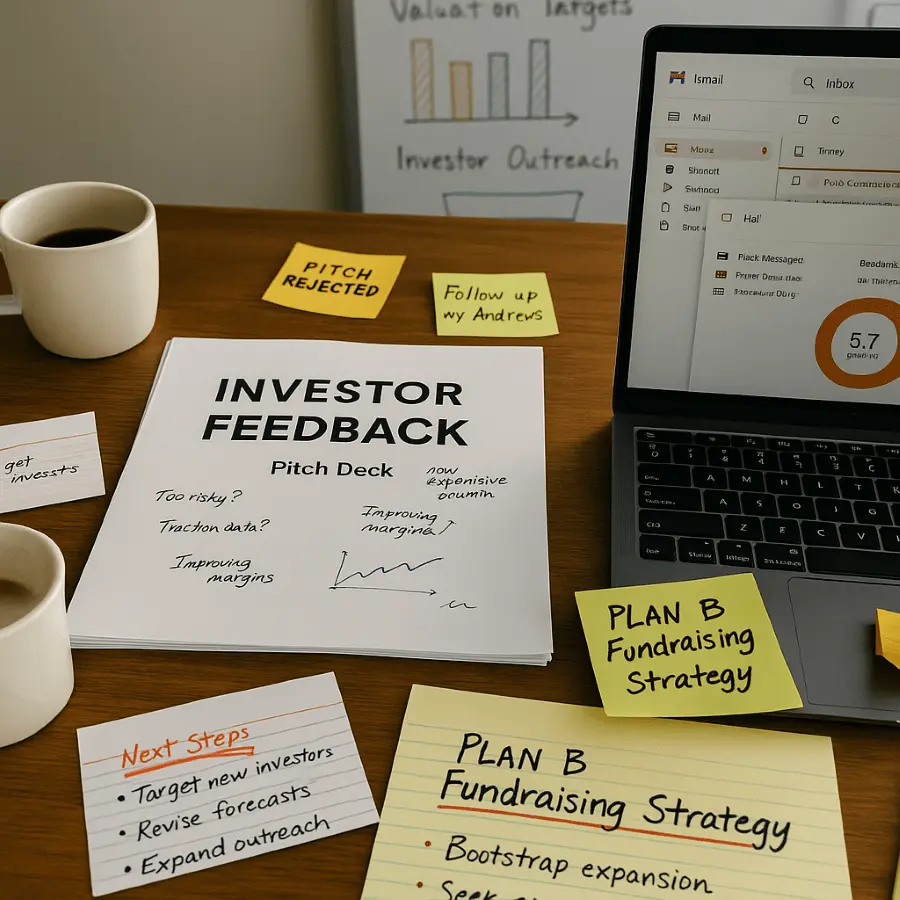The e-commerce sector is one of the most dynamic and competitive spaces in today’s global economy. While the digital marketplace offers unprecedented opportunities for innovation and scale, it also presents unique fundraising challenges that can make or break a start-up’s journey. Whether you’re a first-time founder or a seasoned entrepreneur, understanding these challenges—and how to overcome them—is essential for securing the capital needed to grow your business.
This article explores the core obstacles e-commerce start-ups face when raising funds and provides actionable strategies, real-world examples, and expert resources to help you navigate the path to successful fundraising.
Your exploration of fundraising challenges is enriched by insights from ecommerce startup fundraising strategies, which outlines a broad framework for capital acquisition methods.
Let’s delve into these challenges and uncover actionable strategies to help e-commerce startups thrive.
Understanding the E-Commerce Fundraising
The e-commerce funding landscape has evolved rapidly over the past decade. Investors are more sophisticated, the competition for capital is fiercer, and the bar for operational excellence is higher than ever. Today, founders can access a variety of funding sources, including venture capital, angel investment, crowdfunding, revenue-based financing, and e-commerce-specific lending platforms.
However, while there are more options, the scrutiny from investors has also increased. They’re not just looking for great products, they want to see proof of traction, a clear path to profitability, and operational resilience. If you’re just starting your fundraising journey, it’s essential to understand the full spectrum of options and what investors are looking for.
Proving Traction and Market Fit
The Challenge
Perhaps the most significant hurdle for e-commerce start-ups is proving that there’s real demand for their product and that the business can scale. Investors are inundated with pitches from founders claiming to have the next big thing, but without tangible evidence of traction—such as repeat revenue, high customer retention, or a clear product-market fit—most will walk away.
The Solution
Build Traction Before Fundraising:
Focus on acquiring users, generating repeat purchases, and improving customer engagement metrics before seeking outside capital. Crowdfunding can serve as both a funding source and a powerful validation tool, demonstrating market demand and building a community around your brand.
Leverage Analytics:
Investors want to see hard data—conversion rates, average order value, customer acquisition cost (CAC), and customer lifetime value (LTV). Use analytics to showcase growth and operational discipline.
Inventory and Working Capital Constraints
The Challenge
E-commerce is inherently capital-intensive, especially when it comes to inventory. Traditional equity investors are often reluctant to fund inventory, viewing it as a lower-return use of capital. For founders, using equity to finance inventory can lead to excessive dilution and loss of control.
The Solution
Non-Dilutive Financing Options:
Explore purchase order (PO) and inventory financing to fund stock and fulfill large orders without giving up equity. Revenue-based financing is also gaining traction, allowing repayments to flex with sales cycles and providing founders with greater flexibility.
Maintain Ownership:
By leveraging these non-dilutive options, founders can scale inventory while maintaining more ownership and control over their business.
For a deep dive into these strategies, read Financing Inventory without Dilution: PO & Inventory Options.
Managing Logistics and Fulfillment Risk
The Challenge
Logistics and fulfillment are the backbone of any successful e-commerce business. Failures in this area can erode customer trust, damage brand reputation, and eat into margins. Investors are acutely aware of these risks and will scrutinize your ability to deliver reliably, especially as you scale or expand internationally.
The Solution
Build Strong Partnerships:
Work with reliable logistics partners and third-party logistics (3PL) providers to ensure seamless order fulfillment. Invest in technology for real-time inventory and order tracking.
Document Processes:
Having well-documented logistics processes and risk mitigation strategies is essential for investor due diligence. Show how you handle returns, delays, and cross-border shipping challenges.
For practical steps on de-risking logistics and preparing for investor scrutiny, see Solving Fulfillment & Logistics Risk Before Investor Due-Diligence.
Data Privacy and Regulatory Compliance
The Challenge
With the introduction of stringent data privacy regulations like GDPR and CCPA, compliance failures can result in hefty fines and loss of investor confidence. E-commerce businesses must also address consumer protection and tax obligations across multiple jurisdictions, adding another layer of complexity.
The Solution
Implement Robust Policies:
Establish comprehensive data protection and privacy policies. Stay updated on evolving regulations and ensure your technology stack is compliant.
Be Transparent:
Communicate your compliance measures clearly to investors. Proactive compliance management signals operational maturity and reduces perceived risk.
Overcoming Investor Skepticism and Market Saturation
The Challenge
The e-commerce sector is crowded, and investors are wary of “me-too” businesses that lack differentiation. Many have seen start-ups burn through cash without achieving scale or profitability.
The Solution
Differentiate Your Brand:
Clearly articulate your unique value proposition and competitive advantage. Demonstrate evidence of brand loyalty, repeat business, or proprietary technology.
Personalize Your Pitch:
Research each investor’s portfolio and tailor your pitch to their interests—whether it’s sustainability, technology, or social impact. Highlight strategic partnerships, exclusive supplier agreements, or technology integrations that set you apart.
Addressing Valuation Pressures and Dilution
The Challenge
High competition can inflate valuations, but raising too much too soon can lead to excessive dilution or unrealistic expectations. Founders must balance the need for capital with the long-term impact on ownership and control.
The Solution
Be Realistic:
Use benchmarks and recent comparable deals to set a realistic valuation. Consider alternative funding models like revenue-based financing or inventory loans to minimize dilution.
Milestone-Based Fundraising:
Structure your fundraising in tranches tied to operational milestones, which can help justify valuation increases in future rounds.
Global Expansion
The Challenge
International growth brings new opportunities but also exposes your business to currency risk, cross-border logistics, and regulatory hurdles.
The Solution
Choose Experienced Partners:
Work with funding partners who have experience in global e-commerce. Understand the costs and risks of currency conversion, international shipping, and local compliance.
Plan for Localization:
Map out your expansion plans and show how funds will be allocated to support global growth, including localization and market-specific marketing strategies.
Building a Data-Driven Investor Pitch
Investors want to see data, not just vision. Prepare a pitch that highlights:
- Monthly revenue growth and customer retention rates
- Gross margin trends and unit economics
- Inventory turnover and fulfillment efficiency
- Customer acquisition cost (CAC) vs. lifetime value (LTV)
- Clear use of funds and expected ROI
A data-driven approach demonstrates operational discipline and builds investor confidence.
Leveraging New Funding Platforms
AI-powered venture matching tools and e-commerce-specific lenders are making it easier to find compatible investors and secure fast approvals. Use these platforms to widen your search and improve your odds of securing capital, especially if you’re not yet ready for traditional VC rounds.
Using Crowdfunding as Validation
Crowdfunding is more than a funding source—it’s proof of demand and a marketing tool. Campaigns that reach their goals show investors there’s a real market for your product and help build a loyal customer base before you scale.
Personalizing Your Investor Outreach
Research each investor’s portfolio and preferences. Tailor your pitch to their interests—whether it’s sustainability, technology, or social impact. Personalization increases your chances of a positive response and helps build long-term relationships.
Building Momentum and Engaging Investors
Fundraising is a process, not a one-off event. Keep potential investors engaged with regular updates, progress reports, and early wins. Momentum attracts more interest and can help close your round faster.
Avoiding Common Fundraising Mistakes
- Lack of follow-up: Keep investors engaged with calls, not just emails, and provide regular updates.ets—as noted by Gartner—is a proven strategy among top-performing e-commerce brands. This investment supports continuous refinement of marketing campaigns and user experience.
- Pitching too early: Focus on user traction before seeking investment. Ask investors what milestones would make you investable.
- Ignoring dilution: Understand the long-term impact of giving up equity and explore non-dilutive alternatives.
- Neglecting compliance: Data privacy and regulatory issues can derail deals—make compliance a priority.
- Underestimating logistics: Operational risks can scare investors; document your fulfillment strategy and partners.
Conclusion
Crafting a compelling pitch deck and adopting an integrated funding approach are essential for securing investment. Throughout this blog, we’ve explored strategies to create a narrative-driven presentation that resonates with investors and aligns with your startup’s goals. By focusing on storytelling, clear financial projections, and a well-rounded funding strategy, startups can significantly enhance their chances of success.
At Qubit Capital, we understand the challenges startups face in fundraising. If you're ready to overcome these hurdles, we can help secure the necessary capital through our ecommerce fundraising assistance. Contact us today to get started.
Key Takeaways
- E-commerce startups face unique fundraising challenges that require creative financing solutions.
- Effective cash flow management and alternative inventory financing are crucial.
- Optimized customer acquisition strategies drive growth despite high marketing costs.
- Data-driven measurement and analytics enable continuous improvement.
- A holistic approach to operational and strategic planning is key for long-term success.
Frequently asked Questions
What are the biggest fundraising challenges for ecommerce startups?
E-commerce startups often encounter hurdles such as limited collateral, high marketing expenses, and fierce competition. These factors demand creative approaches to secure funding and sustain growth.






